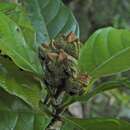fi
nimet breadcrumb-navigoinnissa


Trigonobalanus is a genus of three species of evergreen trees in the family Fagaceae, related to oaks, beeches and chestnuts. The species are widely scattered, with one in northern South America and two in southeast Asia; some botanists treat the three species in separate genera. The three species, with their authors, major synonyms, and distribution, are:
Trigonobalanus is a genus of three species of evergreen trees in the family Fagaceae, related to oaks, beeches and chestnuts. The species are widely scattered, with one in northern South America and two in southeast Asia; some botanists treat the three species in separate genera. The three species, with their authors, major synonyms, and distribution, are:
Trigonobalanus doichangensis (A.Camus) Forman (syn. Formanodendron doichangensis (A.Camus) Nixon & Crepet) - subtropical Yunnan to northern Thailand Trigonobalanus excelsa Lozano, Hern. Cam. & Henao (syn. Colombobalanus excelsa (Lozano, Hern. Cam. & Henao) Nixon & Crepet) - endemic to Colombia Trigonobalanus verticillata Forman - tropical Indonesia and the Malay PeninsulaTrigonobalanus (sinónimos Colombobalanus, Formanodendron)[1] es un género de tres especies de árboles perennes perteneciente a la familia Fagaceae, relacionado con las hayas y castaños. Las especies se encuentran, una en el norte de Suramérica y las otras dos en el sudoeste de Asia. Algunos botánicos tratan las tres especies en géneros separados.
Trigonobalanus (sinónimos Colombobalanus, Formanodendron) es un género de tres especies de árboles perennes perteneciente a la familia Fagaceae, relacionado con las hayas y castaños. Las especies se encuentran, una en el norte de Suramérica y las otras dos en el sudoeste de Asia. Algunos botánicos tratan las tres especies en géneros separados.
Trigonobalanus est un genre de plantes de la famille des Fagacées.
Selon BioLib (25 février 2020)[4], Catalogue of Life (25 février 2020)[5], World Checklist of Selected Plant Families (WCSP) (25 février 2020)[3], The Plant List (25 février 2020)[6] et Tropicos (25 février 2020)[2] :
Trigonobalanus er en slekt med eviggrønne trær i bøkefamilien. Artene vokser svært spredt med én art i nordlige Sør-Amerika og to i Sørøst-Asia. De er derfor ofte blitt plasserte i tre ulike slekter, men fylogenetiske studier viser at disse artene er hverandres nærmeste slektninger. Artene er:
Trigonobalanus er en slekt med eviggrønne trær i bøkefamilien. Artene vokser svært spredt med én art i nordlige Sør-Amerika og to i Sørøst-Asia. De er derfor ofte blitt plasserte i tre ulike slekter, men fylogenetiske studier viser at disse artene er hverandres nærmeste slektninger. Artene er:
Trigonobalanus doichangensis [Formanodendron doichangensis] – den kinesiske provinsen Yunnan og nordlige Thailand Trigonobalanus excelsa [Colombobalanus excelsa] – Colombia Trigonobalanus verticillata – Malaysia, IndonesiaTrigonobalanus Forman – rodzaj roślin z rodziny bukowatych (Fagaceae Dumort.). Według The Plant List w obrębie tego rodzaju znajdują się 3 gatunki[3]. Występuje naturalnie na Półwyspie Indochińskim oraz w Kolumbii. W Europie znaleziono skamieliny roślin z tego rodzaju pochodzące z eocenu[4]. Gatunkiem typowym jest T. verticillata Forman[2].
Trigonobalanus Forman – rodzaj roślin z rodziny bukowatych (Fagaceae Dumort.). Według The Plant List w obrębie tego rodzaju znajdują się 3 gatunki. Występuje naturalnie na Półwyspie Indochińskim oraz w Kolumbii. W Europie znaleziono skamieliny roślin z tego rodzaju pochodzące z eocenu. Gatunkiem typowym jest T. verticillata Forman.
Trigonobalanus é um género botânico pertencente à família Fagaceae[1].
三棱栎属(学名:Trigonobalanus)是壳斗科下的一个属。该属共有2种,分布于泰国北部、马来半岛及加里曼丹。[1]